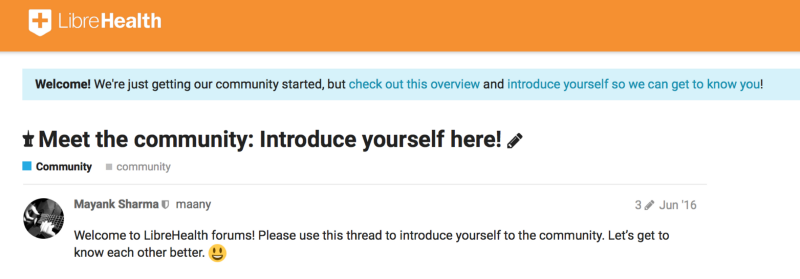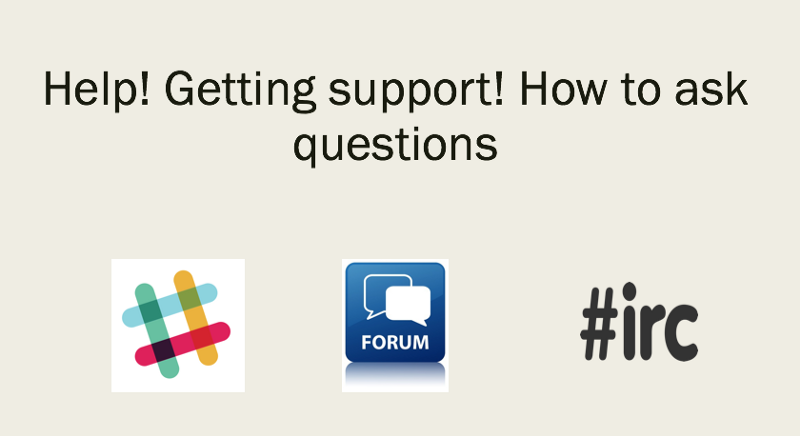Open source and mentoring: writing code that saves lives

I was in my first year at the medical school in 2003 when caring for people with HIV / AIDS was difficult due to the lack of antiretroviral drugs (ARVs). As every medical student knows, the excitement of passing a clinical subordinate is unmatched ... walking through the inpatient rooms with a stethoscope around your neck, taking care of your own patients is one of the main joys of a young medical student.
However, my dreams were shattered rather quickly - I spent more time looking for the results of laboratory tests that were lost. But as Judy usually does, being in the right place at the right time, I contacted Ben Wolfe (the first developer of OpenMRS - the largest open source medical record system in the world, used in more than 40 countries), and the rest is just a story.
I could say that Ben was wondering when the only girl in his class would leave, but those meetings at 4:00 pm at meetings turned out to be the most valuable waste of my time.
')
Looking far ahead - now I have been working in open source software in the health sector for many years as a developer and appraiser — traveling around the world and making new friends whose goal is to improve patient care in places with limited resources. However, I am not one of those who give orders. When I come somewhere I say in an insinuating voice, because most Americans will not miss the opportunity to ask me "What is your accent?". Besides, I'm a colored woman.
However, I can still join the people who are doing an amazing job, most of whom have allowed me to sit on their shoulders and open up countless opportunities for a village girl like me. Summing up how I connect to the network, I realized that my strategy is open source - I voluntarily support the open source X-ray imaging system at librehealth.io and share my experience further. I hope this article will help both mentors and people who want to diversify science, technology, engineering, mathematics and medicine.
1. Welcome to the community
In LibreHealth, the first post we urge to write our new members is a short post about ourselves. I check these posts from time to time and put a thumbs up to new users or like to let them know that someone saw their message.

How can you talk about science, technology, engineering and mathematics to minorities? Share your social capital - even simple things, retweeting people who do amazing work, or noting them anywhere else, if you often visit social networks. Remember that most minorities will be embarrassed to nominate themselves - so thank them for such things as the RedHat open source award or the Anita Borg awards ... Be sure to introduce yourself to people who don't know you yet and break out of your social circle - especially at conferences.
2. Creating a community - how I do it
The task of creating a radiological information system (RIS), which is not directly used by patients, but by doctors, is that your consumer / client pool is small. With the personal motto “people is more important than code”, I work on creating a community before focusing on developer materials.
As for you, as a ward ...
Build your network before you need it.
On my open source journey, this means searching for people using Google — I’ll start with the search query “radiology” + “Congo” and continue to read information about people and organizations working in these countries — linking them to LinkedIn and Twitter and finally presenting them in our project. Every year, I volunteered as a mentor for high school students working in Google Code In, and for university students working in Google Summer of Code on projects in our community.
3 months ago, I noticed a tweet representing blacks at an artificial intelligence training that took place in NIPS 2017 (and turned out to be awesome). I joined the group, and this is how I introduced myself:

I am a radiologist (last year) who works on the display of information. I am currently studying deep learning with an emphasis on cognitive computing, especially studying the role of radiologists in the future organization of the work process in clinical systems.
I also describe the use of artificial intelligence in the clinical organization of the workflow. I am particularly interested in algorithms that integrate with clinical systems and how radiologists can interact with them.
I recently worked on a project for the American College of Radiology in search of a solution in the form of artificial intelligence to determine the age of the bone.
By the way, I'm going to Google this weekend (October 13 or 15) and if someone wants to talk about artificial intelligence in medicine and will be nearby, contact me
I look forward to dating you.
I didn’t know who would answer me - but this letter led to wonderful connections with scientists in the field of machine learning in the Bay area - and as a bonus I received a feedback for a future project, which otherwise would have taken years. Remember that some connections will work, and others - no - do not squeeze out all the juice.
3. Help!
There are many channels for open source project assistance, including Slack or IRC channels:

How / Where do you start creating networks? The online network is simple and much cheaper, but face to face communication is impossible to outdo. For example, at the open source summit hosted by the Linux Foundation, there is a women's dinner, which is informal, allowing people to introduce themselves and the work they do. The Linux Foundation is quite generous in providing comprehensive scholarships for visitors.
In general, for all conferences the most important
Entrance hall
In other words, the people you meet in the hallways and on the stairs, sharing ideas with them and inspiring each other.
4. Git commit
The idea of making code available to the whole world can be quite terrifying, just like mentoring. Recognize and accept the vulnerability of those around you.

5. Dev 1 -> Dev 2 -> Dev 3
Also, as you allow the development of open-source developers, allow your mentoring relationship to grow. For example, after the first conversation with a minority, for example, about diversity, the next natural step should be a discussion of the technical part. Remember that this evolution also means that your mentoring relationship came to an end at some point, and that it should be so.
6. Code of Conduct
Codes of conduct define acceptable behavior within the community. Look for security conditions in your mentoring path, where you can get honest feedback about your work and growth opportunities. It is also important to understand when it is time to move on.
7. Social capital
I say this again, because we geeks love getting a free discount or being a volunteer of the month. Use the same principle for your mentors - give them credit for doing something cool. Reward mentors in your daily work.
8. Starting version 1.0 -> start version 2.0
Remember that relationships with your mentors are always changing. Strive to provide updates for both mentors and wards. What conference have you recently attended? Have you read a new academic article or book? Or is there news about your personal life? ...
Take a roadmap and be agile in solving your important intermediate steps, assessing what works and what does not work. Use version control to control chaos (and conflict) and get inspiration from it to be a terrific ward!
Recently, I read an article by Babson on how to build your “village” as a ward.
I like this idea of a personal board of directors with the following composition (copied from the Babson article ):
- Chairman: the person to whom you first refer; possibly a spouse or family member
- Zen Master: Someone you can count on to be healthy and calm
- Business guru: a professional colleague who knows your craft from inside and outside
- A person who is on the same wavelength with you: someone who thinks the same way as you and has a similar perception
- Devil's Advocate: a man with a strong ability to identify opposing perspectives
- Friend of all life: one who knows your story and helps you stay true to your values
What are your tricks that have worked for you in mentoring (both for a mentor or a ward) ...?
Source: https://habr.com/ru/post/354396/
All Articles